From sleek, multi-purpose tanks to old-school wooden barrels to underground cisterns - we have you covered.
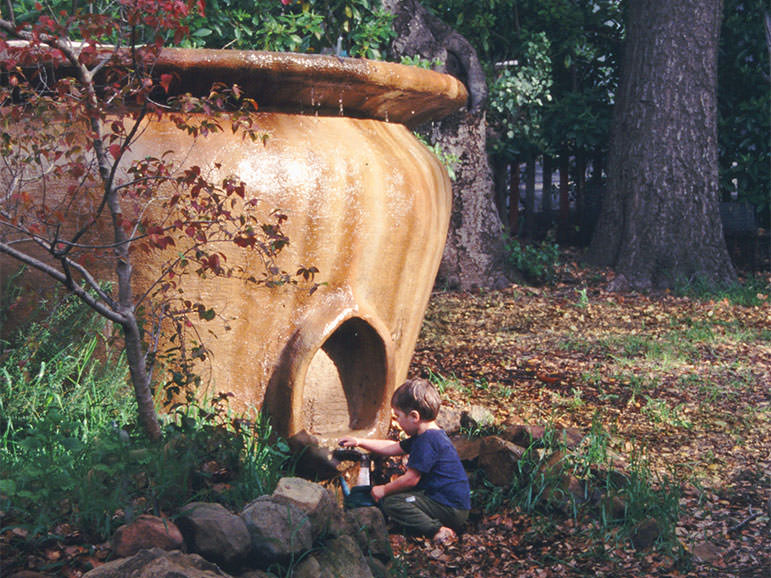
[mf_h2 align=”left” transform=”uppercase”]Artful Ferrocement Tanks[/mf_h2]
In North America, the vast majority of water tanks are made of plastic or metal. In other parts of the world, ferrocement – a construction technique involving concrete reinforced with metal mesh – is quite common, especially in impoverished places where cheap labor is abundant. The beauty of this approach is that almost any shape is possible – urns, eggs, spheres, giant boulders, mandalas – and the exterior can be sculpted, textured and colored as you like.
The materials for this approach cost significantly less than buying a pre-fab tank, though it takes a fair bit of expertise to build a ferrocement tank that is structurally-sound and doesn’t leak. Local permaculture groups often offer workshops in ferrocement construction; the Ferrocement Educational Forum is a good place to connect with ferrocement enthusiasts, find out about classes and events, and trade design ideas.
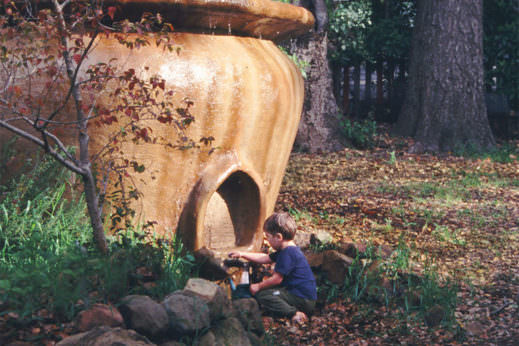
The construction of this urn-shaped ferrocement tank is described by Art Ludwig in his book Water Storage.
[mf_h2 align=”left” transform=”uppercase”]Water Walls[/mf_h2]
Most water tanks are round and bulky, so they stick out like a sore thumb, and they don’t easily fit into small spaces. That’s why a number of companies have developed slim-profile tanks – water walls – that can fit flat against the wall of your house, or even act as an attractive, free-standing landscape feature, much like fence or courtyard wall.
Some of the most compelling examples are from Australia, where water conservation is a serious business. One Australian company makes designer tanks that are meant to be free-standing in the landscape. Another makes structural-strength tanks designed to double as the actual wall of modernist pre-fab homes.
The most architecturally-attractive option available in the U.S. is arguably the Rainwater HOG, which is a system comprised of slim 50-gallon tanks designed to be stacked together like Legos. However, the most widely available option domestically is the (oddly-named) Fat Boy water wall, which kind of resemble a giant, over-stuffed pillow.
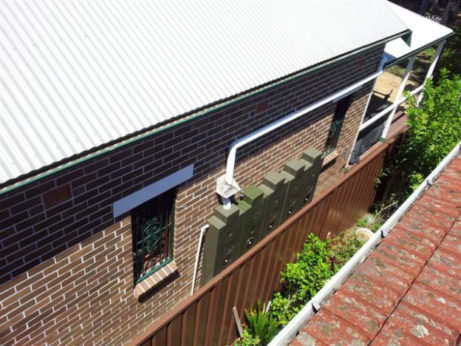
Slim-line 50-gallon HOG plastic tanks link together to store rainwater in tight spaces. Credit: www.rainwaterhog.com
[mf_h2 align=”left” transform=”uppercase”]Tiny Tanks for Tiny Places[/mf_h2]
If you live in an apartment and are looking to catch a bit of rainwater for your potted plants, the standard 50-gallon drum is overkill. You could use a 5-gallon bucket, but Dutch designer Bas van der Veer has invented something much more chic: the Raindrop, a tear-dropped shape tank that slips directly onto a downspout and has a built-in watering can that you can grab whenever your plants are dry. The Raindrop holds 20 gallons, while it’s smaller cousin, the Raindrop Mini (where the watering can is the rain tank) holds just one gallon.
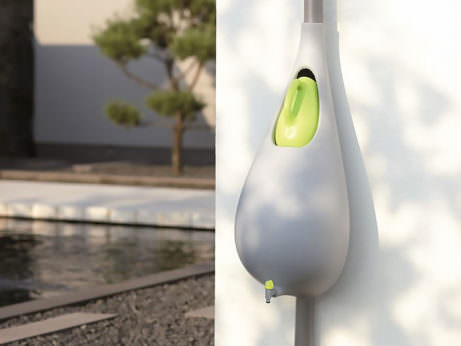
The Raindrop rainwater collection system is perfect for smaller spaces. Credit: Astrid Zuidema, NoPoint.
[mf_h2 align=”left” transform=”uppercase”]The Invisible Rain Tank[/mf_h2]
Don’t want to look at any sort of rain tank in your yard? One option is to bury it underground, in which case the tank would be referred to as a cistern. Cisterns are big space-savers – put a patio, deck, or driveway over it if you like, or simply install it under the garden. Plastic cisterns, which look much like aboveground water tanks (but are designed to resist the weight of the soil around them) are readily available in a multitude of shapes and sizes.
Another approach is called modular underground storage – dig a rectangular hole, line it with a waterproof membrane, and stack it full of what are basically fancy milk crates that provide structural strength to prevent the soil from caving in on the sides and support anything that you might want to put on top (like soil, plants, or paving). These milk crate-like blocks, which go by trade names such as Aquablox and EcoBloc, cost about $1 per gallon of storage and allow you to scale your system from 60 to 60,000 gallons or more.
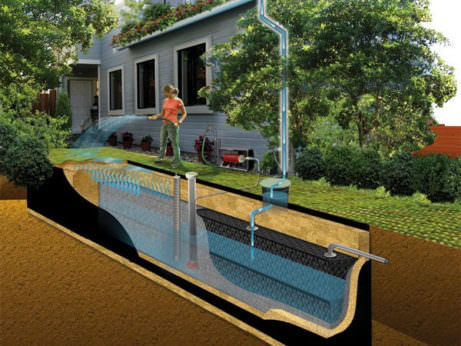
A diagram showing how an underground rainwater collection system could work. Credit.
[mf_h2 align=”left” transform=”uppercase”]Classic Wood Tanks[/mf_h2]
Before plastic, metal, and cement tanks were available, people used wood to build water tanks, typically rot-resistant species like redwood and cedar. Today these antiques are rarely seen, though in the redwood country along the California coast it’s not uncommon to spot 100-year old wooden tanks that are still in use. But because they are so breathtakingly beautiful, specialty suppliers have sprung up in recent years to offer new, custom-made wooden tanks.
New wooden tanks are pricey: they typically cost $2 to $3 per gallon of capacity, while modern plastic tanks run about 50 cents per gallon of capacity. If your carpentry skills are up to par, consider building your own – there are plenty of plans available online. Vertical wooden planks are milled to fit together in a circular form, with heavy-duty metal straps to hold them together against the weight of the water. The water causes the wood to swell, sealing the tiny gaps between the planks to prevent leakage. However, most modern wooden tanks are lined with a waterproof membrane, just in case.
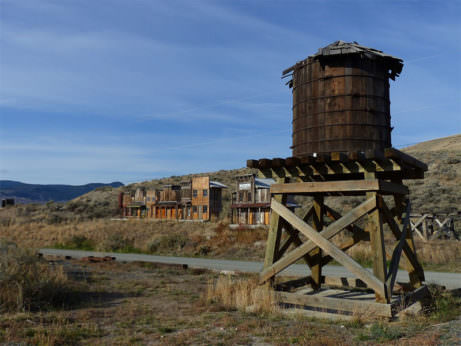
A classic wood rainwater collection tank.
[mf_h2 align=”left” transform=”uppercase”]Fog Catchers[/mf_h2]
This approach isn’t practical for most folks, but it’s fun to consider. People in arid but foggy climates have long devised structures that condense air moisture into water for drinking and irrigation. Today, various charitable groups erect what look like giant sails and futuristic tipis to provide water in places like Peru and Ethiopia, in a modern version of these ancient contraptions.
For most of us, fog catchers are most suitable in places like San Francisco or the Rocky Mountains, where fog and mist are abundant. Unfortunately, there are few off the shelf options available; most are still in prototype form. One of the most promising is a tiny unit by IDEO, a Palo Alto design firm, that mounts outside your window and catches enough water on foggy mornings to water a few plants or brew a pot of coffee. They’re also working on a larger rooftop model.
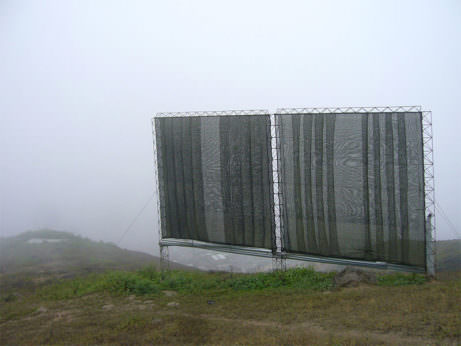
Fog-catchers aren’t practical for most, but those in arid-but-foggy climates, like San Francisco or the Rockies, might be able to put one to use.
[mf_h2 align=”left” transform=”uppercase”]Musical Downspouts[/mf_h2]
In the totally-wacky and definitely-not-available-in-stores department is this rainwater collection system on an apartment building in Dresden, Germany. Not so much a rain tank as an exercise in downspout design, this whimsical installation is intended to make music as the rain washes down through a series of metal pipes sculpted as instruments – though apparently it just sounds like water running through metal pipes. Still, it’s fun to look at and a creative way to get water from roof to tank.

An apartment building in Dresden, Germany, with a very creative downspout design.
https://www.pinterest.com/modfarm/how-tos-gardening/
I HAVE NEVER BEEN ON THIS SITE BEFORE AND JUST FOUND IT THRU PINTEREST. I AM FROM ALASKA AND USE TO SPEND THE WINTERS IN HAWAII ON THE BIG ISLAND AND WORKED BUILDING HOUSES OFF GRID AND THEY WERE ON RAIN CATCH AND ON THE LOWER LEVEL NEAR THE GARAGE WE WOULD INSTALL A CIRCULAR SWIMMING POOL APPROXIMATELY 18ft Round X 48″ WALL 7,646 gals OR A 52″ WALL AT 8,602 gals IT WAS PRETTY AMAZING THAT DURING A FEW HEAVY HAWAIIAN RAINS IT WOULD FILL THE ENTIRE SWIMMING POOL AND SUPPLY WATER FOR AN UNBELIEVABLE AMOUNT OF TIME!!! I… Read more »
Hi there, I found your site on pininterest and am from South Africa. Many villages struggle with water hand carrying from water pumps if they lucky enough to have one. I’ve worked in many communities across Africa that simply dig holes and drink from, which commonly doesn’t pass WHO standards mostly due to excessive TDS and contaminants. Please can you put your collective minds together and post ways small villages can harvest water with limited resources so we can share the knowledge. We have water borehole programs in place however in this world of COVID many sponsors are unable to… Read more »
I FORGOT TO MENTION THAT THE RAIN CATCH SYSTEMS IN HAWAII THAT I WORKED ON, THE HOUSES HAD METAL ROOFS THAT FED THE WATER INTO THE “ABOVE GROUND ROUND SWIMMING POOLS” ON THE LOWER LEVEL OF THE HOUSE BESIDE THE GARAGE. ??
I would love to get information water storage
I’m curious as to how some areas that don’t have water companies near them are able to collect water to use for their personal needs. It’s interesting to know that fog catcher systems can condense air in order to harvest water in there. In my opinion, I think that these types of systems should be beneficial for off-grid communities, especially if water during the hotter season makes it hard for them to gather water at their usual places.